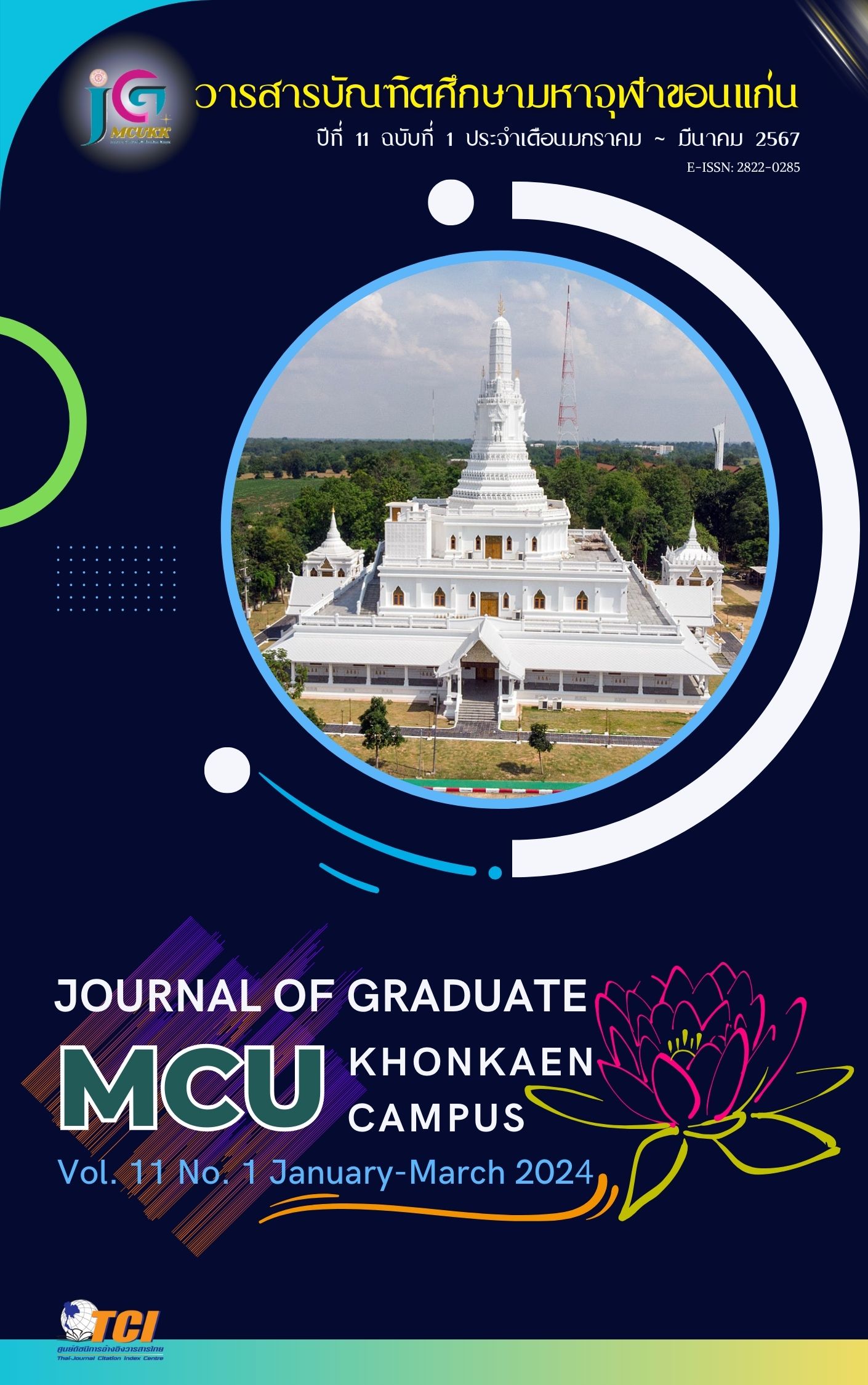School Administrators’ Supervisory Behavior Under the Secondary Educational Service Area Office Kanchanaburi
Main Article Content
Abstract
This research aimed to study and compare the School Administrators’ supervisory behavior under the Secondary Educational Service Area Office Kanchanaburi classified by school size. The sample group for this study was 308 teachers in the secondary educational service area office Kanchanaburi, selected by stratified random sampling, classified by school size. The research instrument was a 5-level rating scale questionnaire with content validity amount 1 and reliability of 0.93 to collect data which were analyzed in terms of percentage, mean, standard deviation, one-way ANOVA, and Scheffe's pair comparison at statistical significance of 0.05.
The findings:
- The level of the characteristics of School Administrators’ supervisory behavior under the Secondary Educational Service Area Office Kanchanaburi was high overall and in separate aspects as written in descending order: non-directive approach was rated at the highest level. with ranking of rating means from top to bottom as follows collaborative approach, directive information approach was rated at the high level and directive control approach was rated at the medium level.
- The comparison of the characteristics of School Administrators’ supervisory behavior under the Secondary Educational Service Area Office Kanchanaburi classified by school size showed that significant not difference overall. with statistical significance at the 0.05 When considering each aspect, it was found that directive control approach was significantly different at the 0.01 level. With large school have School Administrators’ supervisory behavior more than medium school and extra large school.
Article Details

This work is licensed under a Creative Commons Attribution-NonCommercial-NoDerivatives 4.0 International License.
References
กัตติกา สกุลสวน, ภารดี อนันต์นาวี และ มนสิช สิทธิสมบูรณ์. (2565). รูปแบบการนิเทศแนวใหม่เพื่อพัฒนาคุณภาพการจัดการศึกษาของสถานศึกษาในสังกัดสำนักงานเขตพื้นที่การศึกษาประถม ศึกษาปทุมธานี เขต 2. วารสารครุศาสตร์ปริทรรศน์, 9(1), 85-101.
เกลื้อกูล พงไทยสง. (2557). ความสัมพันธ์ระหว่างพฤติกรรมการนิเทศภายในกับประสิทธิภาพการบริหารงานวิชาการของผู้บริหารสถานศึกษา สังกัดสำนักงานเขตพื้นที่การศึกษาประถมศึกษาสุรินทร์ เขต 2. (วิทยานิพนธ์ครุศาสตรมหาบัณฑิต). ร้อยเอ็ด: มหาวิทยาลัยราชภัฏร้อยเอ็ด.
ปฏิพัทธ์ น้อมสูงเนิน และคณะ. (2564). สภาพและปัญหาการนิเทศภายในของสถานศึกษาในอำเภอบุณฑริก สังกัดสำนักงานเขตพื้นที่การศึกษาประถมศึกษาอุบลราชธานี เขต 5. วารสารนวัตกรรมการศึกษาและการวิจัย, 5(1), 90-102.
มะรอฟี เจะเลาะ. (2561). ความสัมพันธ์ระหว่างพฤติกรรมการนิเทศภายในของผู้บริหารสถานศึกษากับขวัญและกำลังใจในการปฏิบัติงานของครู สังกัดสำนักงานเขตพื้นที่การศึกษาประถมศึกษานราธิวาส. (วิทยานิพนธ์ศึกษาศาสตรมหาบัณฑิต). นนทบุรี: มหาวิทยาลัยสุโขทัยธรรมาธิราช.
เมธินี สะไร. (2560). การนิเทศภายในของผู้บริหารสถานศึกษา กลุ่มสหพัฒนา อำเภอรือเสาะ สำนักงานเขตพื้นที่การศึกษาประถมศึกษานราธิวาส เขต 1. (วิทยานิพนธ์ครุศาสตรมหาบัณฑิต). ยะลา: มหาวิทยาลัยราชภัฏยะลา.
รพิรัตน์ เกษมสุข และ สุภาวดี ลาภเจริญ. (2566). ความคิดเห็นของครูผู้สอนที่มีต่อผู้บริหารสถานศึกษาโดยใช้การนิเทศแบบสอนแนะ สังกัดสำนักงานเขตพื้นที่การศึกษาประถมศึกษาปทุมธานี เขต 2. วารสาร มจร อุบลปริทรรศน์, 8(1), 313-326.
โศรยา สาและ และ สุดารัตน์ สารสว่าง. (2558). กระบวนการนิเทศภายในของโรงเรียนที่ได้รับผลกระทบจากความรุนแรงในเหตุการณ์สามจังหวัดชายแดนภาคใต้ในโรงเรียนอำเภอกรงปินัง สังกัดสำนักงานเขตพื้นที่การศึกษาประถมศึกษายะลา เขต 1. วารสารครุศาสตร์, 43(1), 128-138.
สำนักงานเขตพื้นที่การศึกษามัธยมศึกษากาญจนบุรี. (2564). แผนปฏิบัติการประจำปีงบประมาณ พ.ศ. 2565. สืบค้นเมื่อ 30 มิถุนายน 2566, จาก http://www.kan1.go.th/main/
Glickman, C.D., Gordon, S. P. & Ross-Gordon, J. M. (1995). Supervision of Instruction : A development approach (3rd ed.). Boston: Allen and Bacon.
______.(2004). Supervision and instructional leadership: A developmental approach. New York: Pearson.
______. (2009). The basic guide to supervision and instructional leadership. (2nd ed.). Boston: n.p.
Krejcie, R. V., & Morgan, D. W. (1970). Determining sample size for research activities. Educational and Psychological Measurement, 30(3), 607-610.

